Automated DDoS tools drive spike in cyberattacks

Automated DDoS tools drive spike in cyberattacks | Insurance Business New Zealand
Insurance News
Automated DDoS tools drive spike in cyberattacks
Report reveals the other contributing factors
Insurance News
By
Jonalyn Cueto
The 2024 Imperva DDoS Threat Landscape Report has revealed alarming trends in Distributed Denial of Service (DDoS) attacks during the first half of the year. DDoS attacks show no signs of abating, Imperva said. Instead, these attacks are increasing in both frequency and sophistication, posing a significant threat to various industries.
Imperva’s data indicates a staggering 111% increase in DDoS attacks mitigated in the first half of 2024 compared to the same period in 2023. The most significant attack recorded was an application layer DDoS attack in February, which reached an unprecedented 4.7 million requests per second (RPS).
Drivers of DDoS attacks
The automation and ease of access to DDoS tools has been found to be a primary factor, allowing individuals with limited technical expertise to launch significant attacks, the report noted. The shift towards automating these tools has broadened the range of potential attackers, contributing to the increase in DDoS incidents. Additionally, geopolitical tensions have also fueled these attacks. State actors and activists use DDoS attacks to make political statements or signal future actions, further complicating the threat landscape.
In addition, the report revealed the industries that have been particularly targeted. The financial services sector remains the most targeted, accounting for 23.8% of all Layer 7 DDoS attacks. This sector not only faces the highest number of attacks but also the most powerful ones, with a combined RPS of 118 million in the first half of 2024.
Telecommunications and ISPs experienced a staggering 548% increase in attacks. Healthcare organizations as well saw an alarming increase of 236% in attacks, highlighting the potential impact on critical services.
The gaming industry also faced a 208% increase in attacks, affecting online gaming experiences and financial transactions. The report also noted that DDoS attacks targeting industries associated with major sporting events surged by 89%, demonstrating how high-profile events attract cybercriminals.
Imperva also said that political tensions have significantly influenced DDoS activity. The Middle East unrest led to a 118% increase in attacks on Israel, while the Russia-Ukraine conflict resulted in a 519% surge in attacks on Ukraine. Cybersecurity competition saw an 84% rise in attacks on China. These geopolitical factors signify the complex motivations behind many DDoS attacks and the need for vigilance and preparedness.
Recommendations for organizations
The report offers several recommendations for organizations to enhance their cybersecurity posture. During election periods, increased vigilance and robust cyber defenses are essential due to the potential for politically motivated DDoS attacks. Continuous monitoring and updates are crucial to mitigate threats from new variants of the Mirai botnet. As AI technology lowers the barrier for cyber attackers, investing in AI-driven defense mechanisms becomes increasingly important. Staying informed about the activities of major hacking groups also helps organizations anticipate and prepare for new threats.
Imperva’s new report underscores the critical need for organizations to bolster their defenses. With the threat landscape continuously evolving, proactive measures and robust cybersecurity strategies are essential to safeguard against these pervasive attacks.
Do you have something to say about this story? Let us know in the comments below.
Related Stories
Keep up with the latest news and events
Join our mailing list, it’s free!






